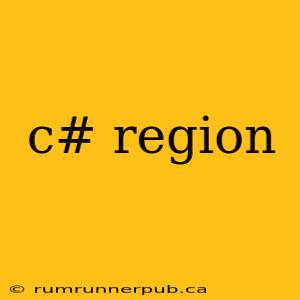C# regions provide a way to collapse sections of code within your IDE, improving readability and maintainability, especially in larger projects. While not affecting compilation or runtime, they're a powerful tool for managing code complexity. This article explores C# regions, drawing on insights from Stack Overflow, and offering practical examples and best practices.
What are C# Regions?
C# regions are code blocks that you can visually collapse or expand in your code editor. They're defined using the #region and #endregion preprocessor directives. This allows you to group logically related code segments, making it easier to navigate and understand large files.
Example (from a Stack Overflow answer similar to this question: How to use #region in C#):
#region MyRegion
// Code related to a specific feature or functionality goes here.
// This section can be collapsed in the IDE.
private void MyMethod()
{
// ... implementation ...
}
#endregion
#region AnotherRegion
// Another logically distinct block of code.
private void AnotherMethod()
{
// ... implementation ...
}
#endregion
The key benefit is improved code organization. Imagine a class with hundreds of lines of code. Regions can separate methods by functionality (e.g., data access, UI updates, validation), making it significantly easier to locate specific parts.
Best Practices and Potential Drawbacks (Inspired by Stack Overflow discussions)
While helpful, regions should be used judiciously. Overuse can lead to a cluttered and confusing codebase. Several Stack Overflow threads highlight the importance of thoughtful region usage:
-
Avoid overly granular regions: Don't create regions for every single method. Group related blocks of code meaningfully. A region for "Database Interaction" is far more helpful than one for each individual database query.
-
Descriptive region names: Use clear and concise names that accurately reflect the code within the region. "Helper Functions" is preferable to "Stuff."
-
Balance with other organization techniques: Regions are a supplementary tool, not a replacement for good code structure, using well-named methods and classes.
-
Consider refactoring: If you find yourself needing many regions in a single class, it might be a sign that you need to refactor your code into smaller, more manageable classes. (This echoes advice frequently found on Stack Overflow related to large classes and methods).
Advanced Usage and Examples
Nested Regions: You can nest regions within other regions for even more granular control, although excessive nesting should be avoided.
#region Database Operations
#region Data Retrieval
// ...code to retrieve data...
#endregion
#region Data Insertion
// ...code to insert data...
#endregion
#endregion
Regions and Code Generation: Code generation tools often use regions to separate automatically generated code from manually written code. This makes it easier to maintain and update generated sections.
Conclusion
C# regions are a valuable tool for enhancing code readability and maintainability. Used thoughtfully, they can significantly improve the developer experience, especially when working with larger codebases. However, remember the best practices outlined above to avoid making your code less organized instead of more. Remember that clear code structure and well-named functions and classes remain crucial, regardless of whether you use regions. The key is balance and mindful application.
